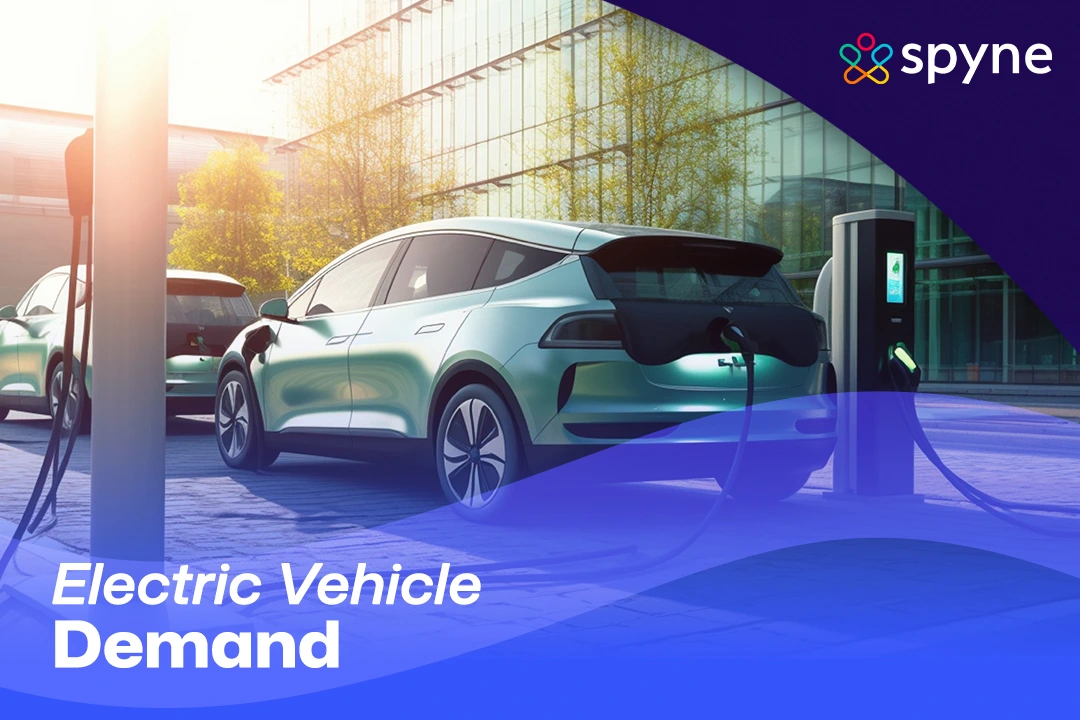Today, electric power is driving a new era of mobility, with electric vehicles (EVs) gaining significant traction. This shift reflects an increasing demand for EVs, a change in consumer attitudes towards sustainability. This has opened a new window of opportunity for auto dealerships to step and fulfill the second hand electric vehicle demand. Available in a wide variety of models, from hatchbacks and sedans to SUVs, EVs are a new category whose potential is yet to be felt in the second hand markets.
As EVs continue to reshape the automotive market, staying ahead of these developments is crucial for dealerships to remain competitive and meet the evolving needs of today’s eco-conscious consumers. Let’s explore.
Electric Car Market Share and Size
The market size is estimated at $387 billion in 2023 and poised to rise more than triple, reaching over $1.3 trillion by 2030. The percentage of electric cars in the world has already reached about 14% of all new car sales worldwide, and that share is going to skyrocket, possibly covering over 60% of global car sales by 2030.
At the start of 2024, electric vehicle sales worldwide are still on the upswing, with major brands experiencing very uneven performance. EV sales 2024 by brand found by dominating the market, keeping a high penetration share of 23.4%, and Tesla was lagging at 11%. Geely-Volvo and Volkswagen Group experience a standalone 7.9% and 5.9% share, respectively.
US Share of Electric Cars
The U.S. electric vehicle market is booming. Electric cars now account for more than 7% of all new car sales in 2023, up dramatically from just a few years ago. The growth of this market has been prompted by incentives from the government, increased charging stations, and the greater availability of electric cars from big brands such as Tesla, Ford, and GM. With further improvement in emission regulations and the upward trend of clean energy advocacy, forecasts for EV sales in the U.S. by 2030 show 20-30% of new car sales.
Why is Electric Vehicle Demand Increasing?
Demand for Electric Vehicle is rising. And there is no one reason for it. Apart from the obvious cost and sustainability benefit, a growing customer preference and ramping up infrastructure are taking the electric car demand forecast to new heights. Here’s a detailed view of why electric vehicle demand is on the rise:
1. Technological Innovation
Technology has dramatically changed over the last few years, making EVs more efficient, practical, and affordable.
Better Battery Technology: Advances in more efficient batteries with greater energy density have been an important factor in enabling EVs to become a real possibility for the mass market. Lithium-ion batteries have been a game-changer, but new technologies – like solid-state batteries, promise even better efficiency and lower cost going forward.
Charging: One of the principal issues that contributed to EV demand falling and limited adoption in the past was the long charging time. Today, this problem is being solved with the advances in fast-charging technology that would cut down on charging time for any vehicle.
Autonomous Driving and Software: EVs are not only about electrification; they are also powering innovation in areas like autonomous driving and smart technology. The integration of AI and advanced sensors is helping to make electric vehicles safer and more efficient, potentially decreasing road accidents and optimising traffic flow.
2. Government Support and Regulation
Government policies around the world play an important role for accelerating the adoption of EVs.
Subsidies and Incentives: Governments have been doling out tax breaks, rebates, and grants to provide a higher level of saving in the purchase of an EV. These are particularly helpful when EVs are too pricey in countries.
Legislation: Some governments have announced plans to phase out the sale of internal combustion engine vehicles. The plan is led by countries like Norway and the UK, which aim to stop the sales of gasoline or diesel vehicles by 2030-2040.
Investment in Charging Infrastructure: Governments are also investing heavily into the development of electric vehicle charging infrastructure. Public-private partnerships are developing charging stations more extensively across urban and rural areas, which are one of the major barriers to EV adoption.
3. Environmental and Social Drivers
The push for sustainability is perhaps the largest driver behind the growth of electric vehicles globally.
Climate Change: The basic need for countries, corporates, and consumers to undertake the journey towards green solutions has been driven by increasing calls to reduce carbon emissions and mitigate the impacts of climate change. Zero tailpipe emissions EVs are integral to this new juncture of change, as they help reduce air pollution and greenhouse gases.
Public awareness: Educating people about the environmental benefits of electric vehicles is increasing, especially in cities, where air quality and congestion are becoming major issues. Many consumers start to see EVs as a contribution to a cleaner city or a healthier planet.
Corporate Responsibility: Companies, especially dealerships and large fleets owners, are adopting EVs to achieve their sustainability goals. Large corporations, such as Amazon, Google, and Walmart, are investing heavily in electric delivery vehicles to curb carbon emission.
Barriers to Wide Scale Adoption of EVs
Global electric vehicle sales statistics indicate a new record in 2024, with estimates of around 16.7 million units sold worldwide, a significant increase from the previous number of 13.9 million in 2023. This growth reflects a continued strong demand for EVs despite challenges in some markets, such as slower growth in Europe. In the first quarter of 2024, sales grew by about 25% compared to the same period in 2023, indicating ongoing robust demand. Although interest in EVs is high, there are some barriers left that may hinder the widespread adoption of EVs.
1. High Up-Front Costs
While prices for EVs have tended to drop in recent years, they are still much more expensive than the traditional ICE vehicles.
Battery Costs: The largest reason behind an EV’s cost remains the expensive battery, which comprises a good part of an EV’s total cost. Although battery prices have had steep declines in recent years, they remain far higher than those of gasoline engines.
Affordability: Price-sensitive consumers, particularly in emerging markets, are not likely to spend money on EVs because they cost more to purchase in advance. With few entry-level electric vehicle options available in many markets, there is a limited market size.
2. Lack of Charging Infrastructure
Availability of charging stations will play a key role in the adoption of EVs.
Limited Coverage: Although the cities are becoming increasingly open to EVs with the increasing number of charging stations, the not-so-friendly scenario in rural areas with limited charging stations is a major cause for concern. This demand for EV charging station needs to be addressed for wide scale adoption.
Long Recharge Time: Even though the state-of-the-art charging technology is available now, the recharge time for an EV is certainly longer than that for a gasoline car. Travellers on long journeys find this a very inconvenient affair.
Grid Stress: As electric vehicles appear more in increasing numbers, the stress on the existing electrical grids goes up. For some regions, the extra demand could prove to be too much for the grid, creating a reliability and efficiency concern.
3. Raw Material Scarcity
Electric vehicle batteries need raw materials like lithium, cobalt, and nickel, which are usually sourced from areas with poor regulatory oversight and environmental concerns.
Environmental Concern: Large-scale extraction of these minerals also contributes to deforestation, soil erosion, and large amounts of water being used. There may be concerns about the long-term effects on the environment if there is such massive adoption of EVs.
Supply Chain Vulnerability: Reliance on a very few countries for such crucial materials leaves the supply chain vulnerable to potential disruptions. Political tensions and trade wars may jeopardies the whole stability of the production of EVs.
4. Consumer Resistance
Despite the awareness, many consumers are yet to switch to adopting EVs because:
Range Anxiety: The fear of being left stranded on long trips with little or no battery power would make the consumer shun the idea of buying an EV if living in a region with limited charging infrastructure.
Lack of Awareness: Many are unaware of their benefits such as cost-saving advantages, reduced maintenance, and savings over time.
Perception Issues: Fewer people regard EVs as less reliable or less practical than traditional cars, especially in the context of performance and robustness and also on long drives.
The Future of Electric Vehicle Demand: Upcoming Trends
The electric vehicle forecast 2030 looks promising as far as innovativeness and consumers’ expectations are involved. The rise in demand has given life to a new segment in the second hand market with dealerships offering well maintained electric vehicles both private and commercial. Here are some of the electric vehicle trends 2024 that will dictate the future of auto industry:
1. Electrification of Public Transport and Commercial Fleets
Besides passenger cars, electric vehicle demand by year is on the rise. The electrification of buses, trucks, and other commercial vehicles is taking the industry forward.
Electric Buses: Cities globally are shifting their bus fleets to electric power to cut down on emissions and improve air quality. For example, Shenzhen in China has fully electrified its public bus system.
Electric Trucks: Companies like Tesla and Rivian are working on electric trucks for commercial use as well as long-haul freight, with goals to cut down emissions in the logistics area.
2. Integration with Renewable Energy
The integration of EVs with renewable sources, such as solar power, is opening up new avenues for a more sustainable lifestyle.
Solar Energy: Solar-powered charging stations for EVs are beginning to be constructed, which cuts the dependence on the grid for electricity.
Energy Storage: With V2G technology, EVs can operate like mobile energy storage units that help in balancing electrical supply and demand on the grid.
3. Autonomous Electric Vehicles
Self-driving EVs are on the horizon. They will completely revolutionize transportation even further.
Safer roads: Safe roads through autonomous vehicles would reduce human errors, the major cause of the accident on roads.
Shared mobility: Autonomous EVs are expected to be at the centre of shared mobility services, like ride-hailing, thereby increasing the scope for commercial vehicles of different categories.
How Can Spyne Help Used Car Dealerships that Deal in EV?
Spyne can adequately support used car dealerships dealing with electric vehicles through tools powered by Artificial Intelligence and streamlining its operations to create an improved customer experience. It helps create precise and real-time reports regarding the condition of second-hand electric vehicles, including a battery health report, to trust the customer.
Spyne is also complementing listings online with quality high-resolution, 360-degree images and videos, improving the appearance of the EVs to potential buyers. The system provides market price information, enables dealerships to price efficiently, and synchronizes seamlessly with inventory management systems to facilitate effective tracking of the fleet. Through personalizing engagement with customers and intensifying efforts on digital marketing, Spyne maximizes dealership conversion by staying ahead in the rapidly increasing electric vehicles market.
Conclusion
The transition toward electric vehicles is a wide-ranging and transforming process that touches on technology, economics, and environment. Despite the enormous challenges in front of it, the momentum toward electric vehicle demand cannot be ignored. With further innovation, government support, and growing consumer demand, the future of electric vehicles is bright. For dealerships, this shift brings a major opportunity. By updating their inventory, offering second-hand EVs, and investing in infrastructure like charging stations, dealerships can meet this new found demand. Adapting to the EV revolution will be key for dealerships to stay competitive in a rapidly changing market.


























